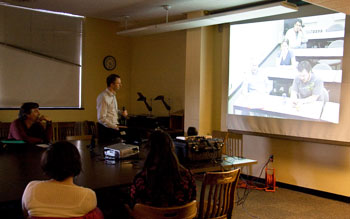 |
|||
| Undergraduate Academic Affairs Home | News | Make a Gift | UW Alumni | |||
|
April 2009 | Return to issue home
Videoconferencing Technology Brings World to UW
Technological innovation in the classroom is not simply a matter of moving from the chalk board to the white board or from overhead transparencies to PowerPoint presentations. A key component to the 21st century classroom is implementing communication technology in teaching. Just as undergraduate research and service learning move the student experience beyond the traditional lecture hall setting, communication technology breaks down the walls of the classroom. Students and faculty now have the ability to draw on global knowledge bases and expertise during real-time class instruction. The videoconferencing services provided by UAA’s Classroom Support Services is a vital part of this transformation in student learning experiences. In fall 2008, a comparative history of ideas class used Classroom Support Services’ videoconferencing to host a live discussion between students here at the University of Washington and students in Egypt. The “Perspectives on Terrorism” class was able to provide new insights into this sensitive and pressing issue by forming a bridge between the experiences of students here and their counterparts in the Middle East. The class was a great success and gave students a safe environment in which to explore the different impacts of this issue. It is offered again this quarter. In many cases, videoconferencing technology also transmits the expertise found at the University of Washington to other parts of the world. Peter Van Elst, a visiting fellow at the UW, spoke live with two classes in Belgium about the U.S. November election on election night. Sometimes videoconferencing helps maintain academic relationships that began at the UW. Bill Talbott, a professor of philosophy at the UW, was invited to give a virtual guest lecture to a class on human rights at the University of Iowa by Ahmed Souaiaia, a former UW graduate student, now a faculty member at Iowa. Some classes, like Eric Smith’s Biology 590, utilize videoconferencing to forge creative partnerships with other institutions to benefit students and faculty in both places. Biology 590 is a seminar series that runs in tandem with Washington State University. One quarter the class is taught from the University of Washington, with videoconference audiences at WSU. The next quarter the situation is reversed. In all these examples—and many more—videoconferencing emerges as a crucial, transformative aspect of the contemporary student experience. Communication technology acts as a two-way street, allowing the global sharing of knowledge and expertise during class time, making the 21st century classroom of today so much larger than the four walls and chalkboards of yesteryear. Photo by Somer Kreisman April 2009 | Return to issue home | |||
|
|||
